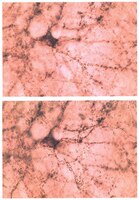Beta-synuclein occurs in vivo in lipid-associated oligomers and forms hetero-oligomers with alpha-synuclein.
E Israeli, R Sharon
Journal of neurochemistry
108
465-74
2009
Pokaż streszczenie
Alpha-synuclein (alphaS) and beta-synuclein (betaS) are homologous proteins implicated in Parkinson's disease and related synucleinopathies. While alphaS is neurotoxic and its aggregation and deposition in Lewy bodies is related to neurodegeneration, betaS is considered as a potent inhibitor of alphaS aggregation and toxicity. No mechanism for the neuroprotective role of betaS has been described before. Here, we report that similar to alphaS, betaS normally occurs in lipid-associated, soluble oligomers in wild-type (WT) mouse brains. We partially purified betaS and alphaS proteins from whole mouse brain by size exclusion followed by ion exchange chromatography and found highly similar elution profiles. Using this technique, we were able to partially separate betaS from alphaS and further separate betaS monomer from its own oligomers. Importantly, we show that although alphaS and betaS share high degree of similarities, betaS oligomerization is not affected by increasing cellular levels of polyunsaturated fatty acids (PUFAs), while alphaS oligomerization is dramatically enhanced by PUFA. We show the in vivo occurrence of hetero-oligomers of alphaS and betaS and suggest that betaS expression inhibits PUFA-enhanced alphaS oligomerization by forming hetero-oligomers up to a quatramer that do not further propagate. Pełny tekst artykułu | 19012742
 |
Spontaneous aggregation and altered intracellular distribution of endogenous alpha-synuclein during neuronal apoptosis.
Antonietta Gentile,Giuseppina Amadoro,Veronica Corsetti,Maria T Ciotti,Annalucia Serafino,Pietro Calissano
Journal of Alzheimer's disease : JAD
13
2008
Pokaż streszczenie
The precursor of the non-amyloid-beta component of Alzheimer's disease amyloid (NACP), also known as alpha-synuclein, is a presynaptic terminal molecule that accumulates in the senile plaques of Alzheimer's disease. Aberrant accumulation of this protein into insoluble aggregates has also been implicated in the pathogenesis of many other neurodegenerative diseases, collectively referred to as synucleinopathies. However, the precise pathogenetic mechanism that leads to aggregate formation and the consequent cellular damage remains elusive. Analyzing differentiated primary cultures of cerebellar granule neurons undergoing apoptosis due to K+ reduction from 25 mM to 5.0 mM, a neuronal model widely used to study event linking apoptosis and neurodegeneration [1], we assessed that endogenous monomeric alpha-synuclein decreases and spontaneously aggregates into detergent-insoluble high molecular species. Apoptosis is also correlated with a marked redistribution/accumulation of this protein from terminal neurites to perikaria, with formation of compact inclusion bodies in juxta-nuclear area. In addition, secretion of monomeric alpha-synuclein decreases in response to apoptotic stimulus, while part of it aggregates into fibrillar structures and becomes detectable by immunogold-electron microscope analysis. The data presented in this study demonstrate that an apoptotic event caused by a physiological trigger, such as neuronal membrane repolarization of cultured cerebellar granule neurons, induces alpha-synuclein intracellular redistribution and aggregation, two molecular events reminiscent of those occurring in different human neurodegenerative diseases all characterized by alpha-synuclein-positive inclusions. Our study indicates this in vitro neuronal system as an excellent model to dissect pathogenic mechanism(s). | 18376057
 |
Parkinson's disease transgenic mitochondrial cybrids generate Lewy inclusion bodies.
Trimmer, Patricia A, et al.
J. Neurochem., 88: 800-12 (2004)
2004
Pokaż streszczenie
Many models of Parkinson's disease (PD) have succeeded in replicating dopaminergic neuron loss or alpha-synuclein aggregation but not the formation of classical Lewy bodies, the pathological hallmark of PD. Our cybrid model of sporadic PD was created by introducing the mitochondrial genes from PD patients into neuroblastoma cells that lack mitochondrial DNA. Previous studies using cybrids have shown that information encoded by mitochondrial DNA in patients contributes to many pathogenic features of sporadic PD. In this paper, we report the generation of fibrillar and vesicular inclusions in a long-term cybrid cell culture model that replicates the essential antigenic and structural features of Lewy bodies in PD brain without the need for exogenous protein expression or inhibition of mitochondrial or proteasomal function. The inclusions generated by PD cybrid cells stained with eosin, thioflavin S, and antibodies to alpha-synuclein, ubiquitin, parkin, synphilin-1, neurofilament, beta-tubulin, the proteasome, nitrotyrosine, and cytochrome c. Future studies of these cybrids will enable us to better understand how Lewy bodies form and what role they play in the pathogenesis of PD. | 14756800
 |
Human alpha-synuclein-harboring familial Parkinson's disease-linked Ala-53 --> Thr mutation causes neurodegenerative disease with alpha-synuclein aggregation in transgenic mice.
Lee, MK; Stirling, W; Xu, Y; Xu, X; Qui, D; Mandir, AS; Dawson, TM; Copeland, NG; Jenkins, NA; Price, DL
Proceedings of the National Academy of Sciences of the United States of America
99
8968-73
2002
Pokaż streszczenie
Mutations in alpha-synuclein (alpha-Syn) cause Parkinson's disease (PD) in a small number of pedigrees with familial PD. Moreover, alpha-Syn accumulates as a major component of Lewy bodies and Lewy neurites, intraneuronal inclusions that are neuropathological hallmarks of PD. To better understand the pathogenic relationship between alterations in the biology of alpha-Syn and PD-associated neurodegeneration, we generated multiple lines of transgenic mice expressing high levels of either wild-type or familial PD-linked Ala-30 --greater than Pro (A30P) or Ala-53 --greater than Thr (A53T) human alpha-Syns. The mice expressing the A53T human alpha-Syn, but not wild-type or the A30P variants, develop adult-onset neurodegenerative disease with a progressive motoric dysfunction leading to death. Pathologically, affected mice exhibit neuronal abnormalities (in perikarya and neurites) including pathological accumulations of alpha-Syn and ubiquitin. Consistent with abnormal neuronal accumulation of alpha-Syn, brain regions with pathology exhibit increases in detergent-insoluble alpha-Syn and alpha-Syn aggregates. Our results demonstrate that the A53T mutant alpha-Syn causes significantly greater in vivo neurotoxicity as compared with other alpha-Syn variants. Further, alpha-Syn-dependent neurodegeneration is associated with abnormal accumulation of detergent-insoluble alpha-Syn. | 12084935
 |












